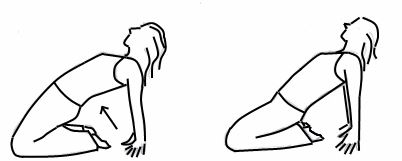How to Do Kegel Exercises and Why They are So Beneficial

When I go to my weekly group exercise lesson at the local gym, the instructor always emphasizes the importance of the pelvic floor muscles. She usually allocates time for exercising the pelvic floor muscles after we’ve finished our workout and lay on the mat. Kegel exercises, which are also known as pelvic floor exercises consist of repeatedly contracting and relaxing the muscles that form part of the pelvic floor, and as you will soon see, they have an important role in our body.
Why Kegel exercises are so important?
Kegel exercises are named after the developer, Dr. Arnold Kegel. The aim of Kegel exercises is to strengthen the pelvic floor muscles and both men and women can tremendously benefit from them. There are many factors that can weaken this muscle, for example, aging, pregnancy, childbirth, surgery and excess weight. You may ask yourself why these muscles are so important. Well, these muscles support the bladder, uterus, small intestine and rectum, so they control the urine flow and keep the pelvic organs in place.
Strengthening these muscles can help you control urinary incontinence when you are not able to keep urine from leaking out of your urethra, the tube that carries urine from your bladder out of your body. It may also help in cases of fecal incontinence when stool is leaking. Or you may be laughing, coughing, sneezing or exercising and leak a few drops of urine. This is called stress incontinence when you lose urine without meaning during physical activity of some sort.
Also pregnant women or women after childbirth can benefit from this exercise, as pregnancy and delivery can stretch and weaken the pelvic floor muscles, thus causing problem to control urine that can last months after giving birth. Also a weak pelvic floor muscles can cause uterine prolapse when the uterus is falling or sliding from its normal position into the vaginal area. So pregnant women should do kegel exercises not just during pregnancy, but also continue them after giving birth.
Kegel exercises can also improve sexual health for women who struggle consistently to reach orgasm. This exercise can help strengthen the vaginal muscles and the result is more intense contractions during orgasm. For men Kegel exercises help improve bladder control, which helps in treating premature ejaculation, and it can also help to treat erectile dysfunction by improving blood flow to the pelvic region.
Doing Kegel exercises is also one of the 70 habits featured in my e-book 70 Powerful Habits For A Great Health which will guide you how to take positive steps to improve your wellness and overall health.
Finding the right muscle
The muscle we are talking about is called the PC muscle. The PC muscle is part of a group of muscles that are known collectively as pelvic floor muscles and include the bladder, sphincter muscles and PC muscle.
Before strengthening the PC muscle, you need to find it and train yourself to control it. To find your PC muscle, try to stop the flow of urine while you are urinating. If you succeed, you’ve got the right muscle. Don’t do it on a frequent basis, just do it once or twice to locate the pelvic floor muscles. Doing it while emptying your bladder can cause to incomplete emptying of the bladder and that increases the risk of a urinary tract infection (also see my previous post on How to Treat Urinary Tract Infection (UTI) Naturally).
Another way to identify the muscle is by trying to keep from passing wind as this is another use of the PC muscle. A third way to locate the muscle is by inserting the tip of one finger into your vagina or anus while squeezing your PC muscle until you feel a contraction around your finger.
How to do the basic kegel exercise
The basic exercise is quite simple to execute. Empty your bladder and sit or lay down. Start by contracting these muscles and hold this contraction for 10 seconds and release. Repeat 4-5 times while having 10 seconds of rest between each contraction. Aim to do it 3 times a day so it is part of your daily routine. If you cannot contract for 10 seconds, start from 5 seconds contraction and 5 seconds rest and gradually increase to 10 seconds.
If you want to get the best results, tighten only your pelvic floor muscles, but don’t tighten the muscles in your abdomen, thighs or buttocks. If your stomach or buttocks muscles tighten, you are not exercising the right muscles. Also don’t hold your breath but continue to breathe regularly during the exercise.
The good thing about this exercise is that you can do it anywhere you want without people noticing it. You can do it while sitting to read or watch TV or while lying on your bed.
If you do Kegel exercise on a regular basis, you can expect results within a few months, but if you want to maintain the results, make it part of your daily routine.
More Pelvic floor exercises
1. Sit back on your heels and place your hands behind your back while they are pointing out. Spread the knees so they are the width of the mat and lift the hips up. Contract your PC muscle for 5 seconds and release slowly. Lower your hips and repeat several times.
2. Sit on the mat while straightening the legs in front of you and spread them a bit wider than your hips. Your arms should be behind your back and the hands are pointing out. Lift your hips and let your head fall back. Contract your PC muscle for 1 second while your hips are lifted and release. Lower your hip and repeat several times.
3. Lie down on your back and place your hands alongside your body. Your legs are bent and your feet flat on the floor. Your knees should be aligned with your toes. Lift your hips until you reach the base of your shoulder blades. When you are in this position pulse up and down. Contract your PC muscle when your hips are lifted. Lower your hips and repeat several times.



